
|
|

October 30, 2009
KYPA (KGFJ) 1230, Los Angeles
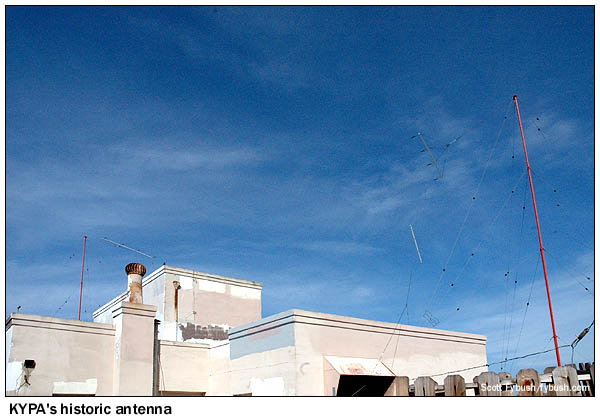
Welcome to our new season of Tower Site of the Week - and the latest in a series of TSoTW installments showcasing the images you'll find in the brand-new Tower Site Calendar 2010, arriving any day now in a mailbox near you.
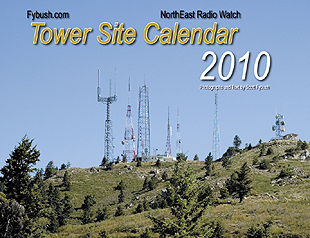 (It's
more than just pretty pictures and dates - the modest sum we
raise from each year's calendar helps make possible the travel
needed to make this feature happen every week on the website...and
we're grateful for all your support!)
(It's
more than just pretty pictures and dates - the modest sum we
raise from each year's calendar helps make possible the travel
needed to make this feature happen every week on the website...and
we're grateful for all your support!)
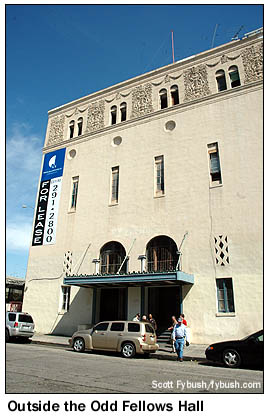 An
early edition of the Tower Site Calendar featured a view of one
of the nation's most unusual AM antennas, the "hammock"-style
horizonal radiator of KYPA (1230) in Los Angeles, a site that's
been in nearly continuous use since 1927 - but that view was
from ground level, five stories below the rooftop antenna, and
we'd always hoped for a chance to get a closer look at what was
apparently the last of those hammock antennas still in use in
the U.S.
An
early edition of the Tower Site Calendar featured a view of one
of the nation's most unusual AM antennas, the "hammock"-style
horizonal radiator of KYPA (1230) in Los Angeles, a site that's
been in nearly continuous use since 1927 - but that view was
from ground level, five stories below the rooftop antenna, and
we'd always hoped for a chance to get a closer look at what was
apparently the last of those hammock antennas still in use in
the U.S.
We got that chance in the spring of 2008, during our nearly-annual visit to Los Angeles in the week before the big NAB Show in Las Vegas. This time around, the nice folks at the local chapter of the Society of Broadcast Engineers, chapter 47, asked me to give my "Tower Sites I've Known and Photographed" slide show, which I was happy to do. I showed that ground-level photo of the KYPA antenna and mentioned that I'd always wanted to see it...and a hand went up from the back of the room: "OK. I have the key. What time do you want to meet me there tomorrow?"
(Have I mentioned how much I love speaking to SBE chapter meetings?)
It turns out I wasn't the only one who wanted a look at this most interesting facility: by the following afternoon, close to a dozen LA engineers had taken time out of their schedules to tag along on what turned out to be a sort of impromptu engineering field trip to a site steeped in early broadcasting history, not to mention a building full of ghosts of all kinds.
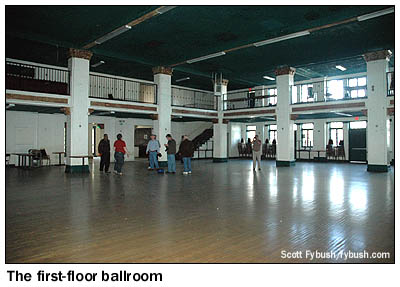 |
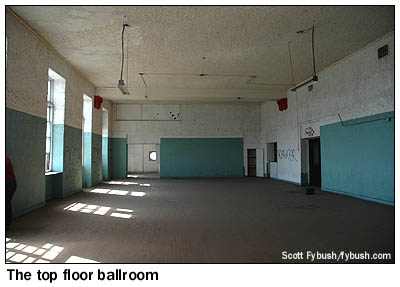 |
So, about that history: the station now known as KYPA spent
most of its long life as KGFJ, founded in 1927 right here at
the Odd Fellows Hall on Washington Boulevard, just south of 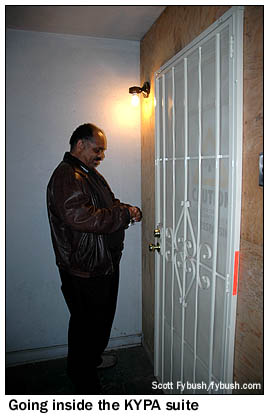 downtown Los Angeles
next to what would eventually become the junction of the 10 and
110 freeways. Under owner Ben McGlashan, KGFJ boasted numerous
"firsts" - it was the first station in the country
to maintain a 24-hour broadcast schedule on a regular basis,
and by the fifties, it was one of only a handful of stations
targeting a black audience.
downtown Los Angeles
next to what would eventually become the junction of the 10 and
110 freeways. Under owner Ben McGlashan, KGFJ boasted numerous
"firsts" - it was the first station in the country
to maintain a 24-hour broadcast schedule on a regular basis,
and by the fifties, it was one of only a handful of stations
targeting a black audience.
(It was also one of the last 100-watt operations left on the AM dial; while other class IV/class C stations boosted power to 250 and then to 1000 watts full-time, KGFJ could do so for only part of its broadcast week, constrained by a short-spacing to KPPC 1240 in nearby Pasadena that forced KGFJ to drop back to 100 watts on Wednesday nights and Sundays when KPPC was on the air. That situation finally ended in the nineties, when both stations came under common ownership and the Pasadena license was surrendered.)
In time, the studios moved out and the calls changed - to KKTT for a brief time in the late seventies, then back to KGFJ, then to KYPA in the nineties when the station took on a motivational talk format ("Your Personal Achievement") before becoming a leased-time station with Korean-language programming.
By the time of our April 2008 visit, the neighborhood around the Odd Fellows Hall had become rather sketchy, and the building itself had been vacated by everyone but KYPA - so our visit was as much about industrial/architectural archaeology as it was about radio, poking around the big ballrooms that must once have been very impressive parts of the building in its heyday.
KGFJ was an important tenant here, once upon a time: in addition to housing the station's transmitter on the top floor and the antenna on the roof, the KGFJ studios were here as well, and that top-floor ballroom must once have been the site for live orchestra broadcasts. Look closely at the back wall in that photo above and note the boarded-up area near the top of the wall.
Back in the station's heyday, that was a window that looked down from the transmitter room and control room, and it's fun to imagine the engineer up there cueing the band down below to start playing when it was time for the big broadcast to begin.
Ready to see what's behind those boards today - or at least what was there in 2008? For that, we exit the ballroom and go one more flight up the wide stairwell to the very top floor, where an incongruously-placed screen door leads in to the KYPA transmitter space...
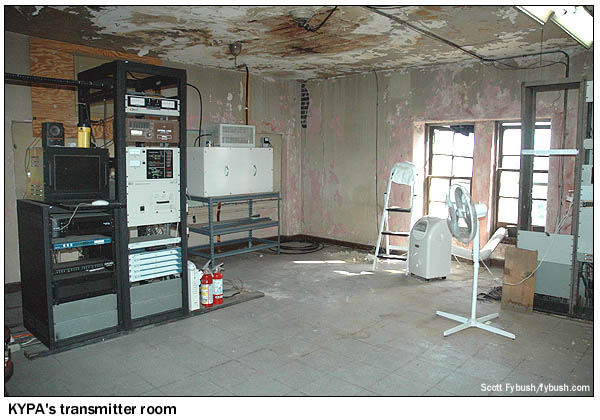
The engineers who put KGFJ on the air in 1927, as a 100-watt signal, would surely have been stunned to know that a 1000-watt transmitter could be contained in that little beige box in the second rack from the left, but we recognize that as a standard-issue BE solid-state transmitter, surrounded by the usual processing and STL gear and not much else. That's the ATU sitting to the right of the transmitter, backing up to the boarded-up window that once looked down to the ballroom below - and that's the transmission line going up from the ATU to the ceiling, and to the antenna just above. So let's follow it, shall we?
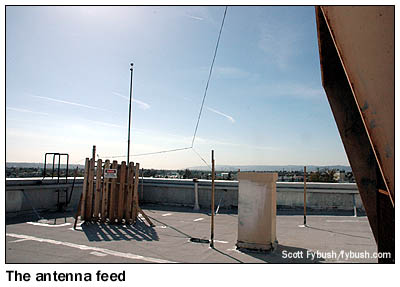 |
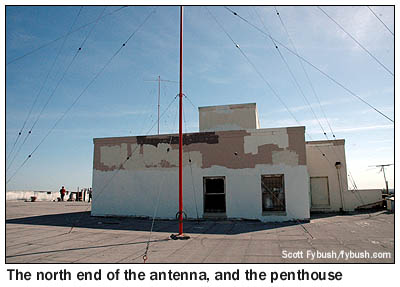 |
Up on the roof, we're briefly distracted by the skyline view of downtown Los Angeles to the northwest and the 10/110 interchange in the foreground, but our attention quickly turns to the antenna, with its four parallel horizontal longwire elements suspended from two short poles mounted on the rooftop, on either side of the penthouse with its antique elevator machinery (seen below at left) and empty rooms that were apparently once occupied by KGFJ engineers in decades past.
On the south side of the penthouse, the feedline for the antenna comes down to the roof, where it passes straight down into the transmitter room directly below.
It should be noted that this is not the original 1927 antenna, and herein lies the end of our story: KYPA's current owner, Multicultural Broadcasting, had already tried to move the station at least once before our 2008 visit. As early as 2005, Multicultural had tried to relocate KYPA a few miles to the northwest, moving it to one of the towers of sister station KBLA (1580) near Dodger Stadium. (You can see our photos of that site on an earlier Site of the Week installment.)
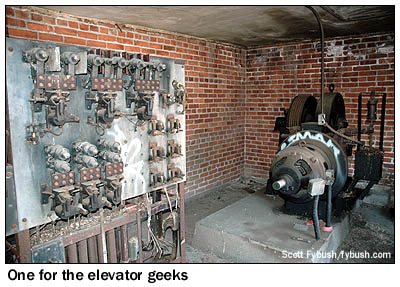 |
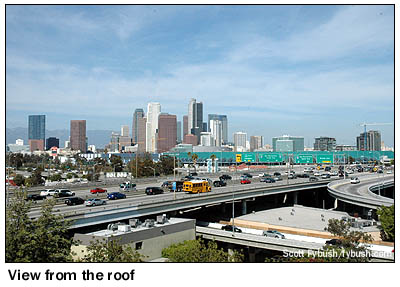 |
The antenna atop the Odd Fellows Hall - which had already been completely rebuilt at least once since 1927 - was dismantled during that first move, and then quickly reinstalled when it became clear that the KBLA site provided significantly worse coverage of KYPA's target audience in LA's Koreatown than the Odd Fellows Hall site offered. (No surprise there: the Odd Fellows Hall is significantly closer to Koreatown, and the longwire antenna, while licensed nondirectional, provided some degree of directionality that helped boost 1230's signal toward Koreatown.)
In the end, though, it was apparently a rent increase that did this site in, and 82 years of operation from the Odd Fellows Hall rooftop finally came to an end on January 14, 2009, when the plug was pulled on this site for the last time, as KYPA again moved to the KBLA site, this time for good, closing a long and fascinating chapter in American radio history.
- Previous Site of the Week: Deer Point, Boise, ID
- Next Week: WGHP, High Point, NC
- Site of the Week INDEX!
- How can you help support Site of the Week? Click here!
- Submit your suggestions for a future Site of the Week!
